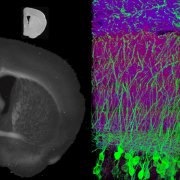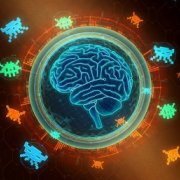April 10, 2015 - 9:00 am
This meeting is invitation only.
April 7, 2015 - 4:15 pm
MIT
Lindsey Powell (CBMM Thrust 1, CBMM Thrust 4)
Topic: Infants' Understanding of Social Actions
Abstract: Intentional human actions fall into at least two partially separable classes -- actions aimed at interacting with objects and actions aimed at interacting with people. The principles by which these two types of actions are effective vary...
Abstract: Intentional human actions fall into at least two partially separable classes -- actions aimed at interacting with objects and actions aimed at interacting with people. The principles by which these two types of actions are effective vary...
April 7, 2015 - 2:30 pm
McGovern Institute for Brain Science at MIT, Room 46-5165
By invitation only.
March 31, 2015 - 4:00 pm
Ryan Adams, Harvard University
Abstract:
Recent work on molecular programming has explored new possibilities for computational abstractions with biomolecules, including logic gates, neural networks, and linear systems. In the future such abstractions might enable nanoscale devices that can sense and control the world at a...
Recent work on molecular programming has explored new possibilities for computational abstractions with biomolecules, including logic gates, neural networks, and linear systems. In the future such abstractions might enable nanoscale devices that can sense and control the world at a...
March 23, 2015 - 4:00 pm
MIT: McGovern Institute Singleton Auditorium, 46-3002
Prof. Amnon Shashua, Hebrew University, Co-founder, Chairman & CTO, Mobileye (NYSE:MBLY), OrCam.
Brief Biography:
Amnon Shashua holds the Sachs chair in computer science at the Hebrew University. He received his Ph.D. degree in 1993 from the AI lab at MIT working on computational vision where he pioneered work on multiple view geometry and the recognition of objects under variable lighting....
Amnon Shashua holds the Sachs chair in computer science at the Hebrew University. He received his Ph.D. degree in 1993 from the AI lab at MIT working on computational vision where he pioneered work on multiple view geometry and the recognition of objects under variable lighting....
March 10, 2015 - 4:00 pm
Harvard University Northwest Bldg, Room 243
Ed Boyden, CBMM Thrust 2: Circuits for Intelligence
Abstract:
Ideally we would have maps of the molecular and anatomical circuitry of the brain, as well as of the dynamic activity of the brain, with sufficient detail to reveal how brain circuits generate the computations that support intelligent behavior. Our group is working
on three new...
Ideally we would have maps of the molecular and anatomical circuitry of the brain, as well as of the dynamic activity of the brain, with sufficient detail to reveal how brain circuits generate the computations that support intelligent behavior. Our group is working
on three new...
A compilation of the Brains, Minds and Machines Summer Course 2014 projects is now available online.
March 9, 2015 - 2:00 pm
A compilation of abstracts from the student projects of the 2014 Brains, Minds, and Machines Summer Course has been published online as CBMM Memo 024.
The inaugural Center for Brains, Minds and Machines (CBMM) Summer Course was held at the Marine Biological Laboratory in Woods Hole, from May 29 through June 12, 2014. The school was attended by 25 graduate students and postdocs from around the world, and provided a "deep end" introduction to the...
March 3, 2015 - 4:00 pm
Max Tegmark
The Future of AI: Opportunities and Challenges
Abstract: I will give a report from the recent Puerto Rico conference on this topic (http://futureoflife.org/misc/ai_conference) and lead a discussion of what we can do today to help maximize the future benefits of AI while avoiding pitfalls.
Abstract: I will give a report from the recent Puerto Rico conference on this topic (http://futureoflife.org/misc/ai_conference) and lead a discussion of what we can do today to help maximize the future benefits of AI while avoiding pitfalls.
March 2, 2015 - 10:00 am
Prof. Shimon Ullman was awarded the 2015 Israel Prize in Mathematics and Computer Science Research. The Israel Prize committee cited Ullman for his “far-reaching contributions to artificial intelligence and general cognition, and particularly in the field of computer vision, and for his significant contribution to the development of the hightech industry in Israel.”
The Israel Prize is awarded to Israeli cisizens for displayed excellence in...
February 25, 2015 - 2:30 pm
DeepMind computer provides new way to investigate how the brain works.
By Elizabeth Gibney
CBMM Partner - DeepMind's research is the focus of a recent Nature article. The online article includes a video featuring interviews with Demis Hassabis and some of the DeepMind developers.
Both, the article and video, discuss the recently published Nature paper by DeepMind, titled "Human-level control through deep reinforcement learning," which...
February 24, 2015 - 4:00 pm
Jorie Koster-Hale, CBMM Thrust 4 (MIT, Saxe Lab), Moral Psychology Lab (Harvard U.)
Topic: Thinking in patterns: representations in the neural basis of theory of mind
Abstract: Social life depends on understanding other people’s behavior: why they do the things they do, and what they are likely to do next. These actions are just observable consequences of an unobservable, internal...
Abstract: Social life depends on understanding other people’s behavior: why they do the things they do, and what they are likely to do next. These actions are just observable consequences of an unobservable, internal...









